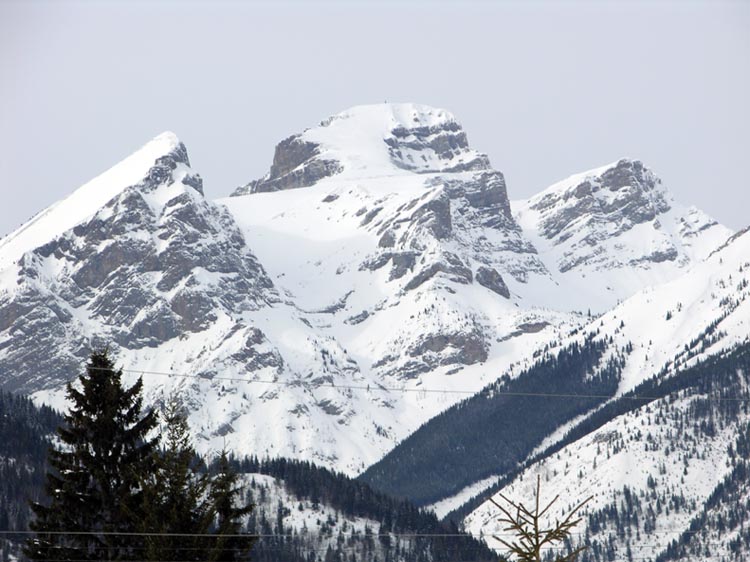Everyone Can Count to Two
by Jon Turk
It was a March morning, many years ago. We had sledded up behind the Three Sisters, near Fernie and were skinning up, chatting, anticipating a great day of touring. The sky was blue and avalanche danger in the alpine low; what was there not to like? The sun crested the ridge with an ethereal glow highlighting the limestone cliffs and the cornices that danced rainbows in the crystalline air. Then the cirque filled with an eerie and unexpected roar and the whole mountain cut loose in the biggest avalanche that I have seen in my twenty years in the East Kootenays. When we later climbed up to investigate, the debris had filled the bottom of the bowl and obliterated “safe zones” that we normally rely on. If we had been half an hour earlier, or the avalanche a bit later, our whole group would have perished.

I write this in response to, and support of, the excellent post by James Floyer, of the Canadian Avalanche Center, called “Mount Fernie Avalanche Discussion.” Floyer wrote about an avalanche that occurred on a “safe day” when the forecasted danger level was low and people were whooping it up all over the ranges. He advised, “You should think about the notion of residual risk. This is the chance of an unexpected, surprise event happening, despite best attempts at analyzing all the various risk factors involved.”
I’ve been an adventurer for forty years and in that time several of my best friends, including my wife, have died doing what they love. I’m 67 years old and occasionally, if only for an instant, have thought about quitting. But what does that mean? Quitting being me? Huh? Yesterday I found myself skiing alone, in heavy snowfall, in near whiteout conditions, on a big, known slide-path that I had been caught in 15 years ago. It was so beautiful up there, in the silence, with the world shut out by the storm, skiing face shots and dodging sluff.
I am not an avalanche expert. I never took my Avy 1, and the only time I worked in the ski industry was when I ran a chain saw on a summer trail crew. I’m reasonably handy with a saw, but I didn’t make the cut to lifty when the snow fell.
With that disclaimer, I offer a little advice gleaned from all the glory and tragedy. If you can count to two, here are three seemingly obvious rules that might help you live a little bit longer.
1. Ski one at a time on big slopes. If someone is skiing, think. “One person is out there, in the danger zone. Let’s see now. If I start, that will make it two, thereby doubling the risk and doubling the consequences should a chance event occur. I’ll wait.”
2. Most avalanches occur during a storm or within the following 24 hours. So count to two. “It is snowing today; I’ll ride the chair lifts. It snowed yesterday; I’ll wait. Tomorrow I’ll go into the back country.” (So what was I doing in the backcountry yesterday? Breaking the rules. You be the judge.)
3. If the snow talks to you, by woomphing, releasing small slabs, or whatever, think, “The snow is talking to me, as a friendly warning. Thank you, snow. I will not wait for the second speech, which could be a horrendous avalanche. Thank you for the warning; I’ll go home now.”
Following the rule of two’s will get you an A- in avalanche forecasting — which means that you’ll be right 90 % of the time. Which means that you will be caught in an avalanche once out of every ten times you go touring. Nope, an A- is not nearly good enough.
So, there are two more things to learn: how layering affects snowpack and avalanches, and how to judiciously choose terrain.
You learn about layering in an Avy 1 course. Since we have already established that I am not an avalanche expert, read a book, take a course, dig a zillion pits; study snow.
You learn about terrain from a lifetime on snow. In every incident that I have been involved in, the person who triggered the avalanche was not the first skier, but the second or the third. Now, this is not a statistically significant sampling, and the first skier is often the person who gets in trouble. But on the other hand, if there is a question about stability, and the first skier “gets away with it” the second skier may be tempted to ski a slightly bolder line.
For me, the joy and the challenge of back country skiing is understanding terrain. “What can I ski?” Or more exactly, “What can I ski today.” So, my advice: TUNE IN to the mountains; TURN ON to the conditions underfoot, and DROP OUT of the misconception that you really know what’s going on out there.










Comments